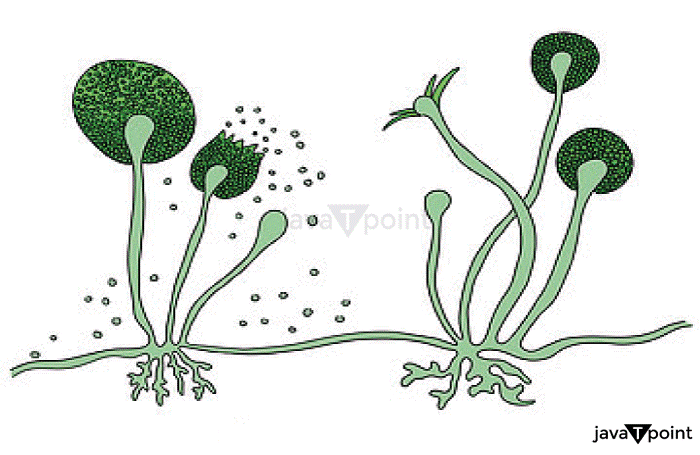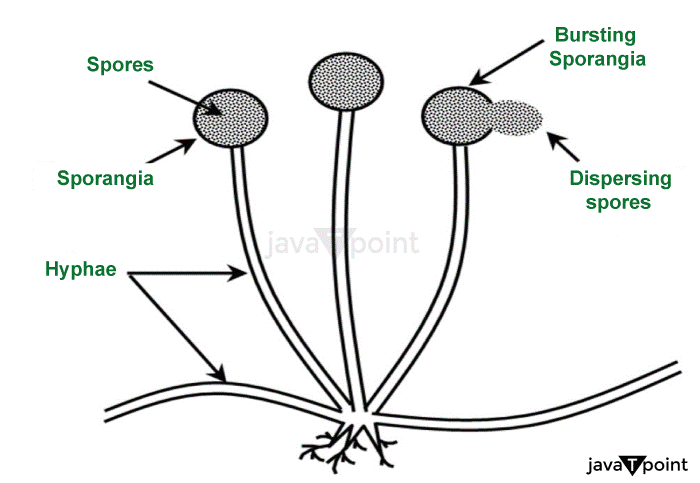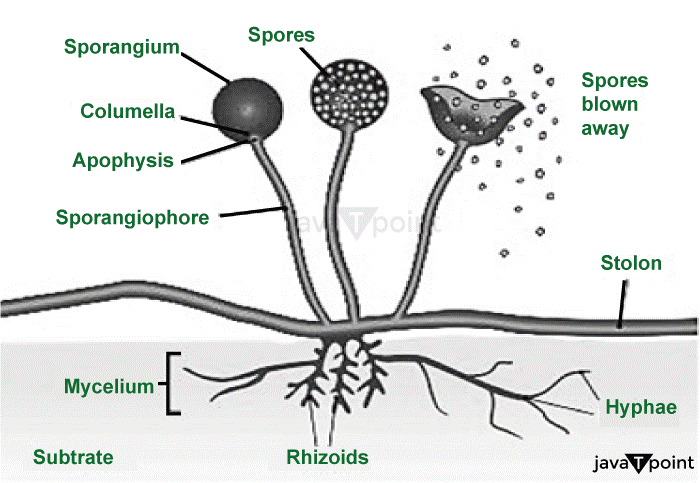Spore Formation DefinitionSpore Formation is defined as a method of Asexual Reproduction. Sporangia, which are large sacs, contain a lot of spores. As the spore sac bursts, the plants release hundreds of spores. These spores are released into the atmosphere, where they grow to produce a new plant under the right circumstances. 
IntroductionA spore is a unit of sexual or asexual reproduction in fungi that can be modified for dissemination and survival in challenging environments, frequently for long periods. Many plants, algae, fungi, and protozoa use spores as part of their life cycles. Bacterial spores are resistant structures used for survival in poor environments; they are not a component of a sexual cycle. In addition to infecting its hosts with amoeboid infectious germs (known as "amoebae"), myxozoan spores also reproduce inside their hosts by mating two nuclei in the plasmodium that forms from the amoeba. Sporangia of a diploid sporophyte undergo meiosis to create spores, which are often haploid and unicellular in plants. A multicellular gametophyte that eventually gives rise to gametes can be produced by the spore by a mitotic division under the right circumstances. A zygote is created when two gametes combine and grow into a brand-new sporophyte. This cycle is referred to as a generational alternation. The megaspores, which are formed within the ovules, and the microspores, which are involved in the production of more complicated structures that comprise the propagation units, the seeds, and the pollen grains, are produced internally by seed plants. In everyday language, a "spore" & a "gamete" are different in that a spore will begin to grow before evolving into a sporeling. In contrast, a gamete must unite with a different gamete for the formation of a zygote before continuing to develop. As dispersal units, spores, and seeds differ primarily in that seeds contain an embryo that is developing (the multicellular sporophyte of the next generation), which is created by the union of the male gamete of a pollen tube with the female gamete created by the mega gametophyte within the ovule. Spores are unicellular in nature, the first cell of a gametophyte. Seeds germinate to produce diploid sporophytes, whereas spores produce haploid gametophytes. Spore MeaningA spore is a type of reproductive cell that may create a new organism without fusing with a different reproductive cell. Thus, gametes?reproductive cells that must pair up in order to create a new individual?differ from spores. Gametes are the sexual reproduction agents, whereas spores are the asexual reproduction agents. Aside from plants, algae, and fungi, bacteria also produce spores. The main purpose of bacterial spores is to protect the bacterium during times of poor environment by acting as a resting or inactive stage in the bacterium's life cycle. Bacillus & Clostridium bacteria, some kinds of which cause disease, produce spores very often. Numerous bacterial spores have high resistance and can still germinate years after going dormant. Spores play a role similar to seeds in plants among the fungus. Under ideal circumstances of temperature, humidity, and food availability, fungal spores are generated and released by specialized fruiting bodies that include the edible part of the familiar mushroom. Many larger algae have both the ability to reproduce sexually and by spores. A variety of red algae creatures produce monospores, which are spherical cells without walls that are conveyed by water currents and, upon germination, develop into new organisms. Some green algae create aplanospores, which are nonmotile spores, while others produce motile zoospores that lack real cell walls but include at least two flagella. In contrast to monospores and aplanospores, which must rely on passive water current transmission, zoospores can swim to a good environment where they can develop. Spores are the reproductive entities of the asexual generation of plants, which all have a life cycle that alternates generations of sexually and asexually reproducing individuals. Plant spores, or spore-bearing generation, give rise to a haploid or gamete-bearing generation. The non-seed-bearing plants, such as mosses, ferns, liverworts, and hornworts, are where spores are most noticeable. The spores in these smaller plants serve a similar purpose as seeds in fungi. The parent plant often releases the spores locally, and the spore-producing organs are frequently seen on the undersides of the leaves. Occasionally shedding into the water or transported there by rain, the spores of the plants that live along bog or lake margins remain intact in the sediments. A factor in plants that release their spores explosively is wind dispersal. Spore Formation in Plants in Other Organisms1. Bacterial SporesEndospores are spores that some bacteria produce to protect themselves from harsh environmental circumstances that endanger their survival. High temperatures, aridity, the presence of poisonous chemicals or enzymes, and a lack of food are some of these circumstances. Spore-forming bacteria build a robust and waterproof cell wall to shield their DNA from desiccation & damage. Endospores can endure for a very long time before the environment changes and becomes favourable for germination. The bacteria Clostridium and Bacillus are two examples of those that can produce endospores. 2. Spores of algaeAs a method of asexual reproduction, algae create spores. These spores can travel from one location to another utilizing flagella or be non-motile (aplanospores). Some algae have the ability to reproduce sexually or asexually. When conditions are right, mature algae reproduce by splitting into spores, then growing into new individuals. Mitosis is used to create the haploid spores. When conditions are not ideal for growth, the algae engage in sexual reproduction to create gametes. Upon fusing, these sex cells form a diploid zygospore. The zygospore won't start to grow until the environment is right again. The zygospore will next go through meiosis to create haploid spores at that point. Some algae have distinct asexual and sexual reproductive phases that alternate throughout their life cycle. The haploid and diploid phases of this life cycle type, also known as the alternation of generations, are both present. A structure known as a gametophyte creates male and female gametes that develop during the haploid phase. A zygote is created when these gametes combine. During the diploid phase, the zygote transforms into a sporophyte, a diploid structure. Through meiosis, the sporophyte creates haploid spores. 3. Yeast SporesThe majority of fungi's spores have two main functions: to reproduce by dispersing and to survive by going dormant. Depending on the fungus, spores might have one or many cells. Depending on the species, they occur in a wide range of hues and shapes. Both asexual and sexual spores of fungi exist. Sporangia are microscopic organs that create and store asexual spores like sporangiospores. Conidia and other asexual spores are generated on filamentous organs known as hyphae. Ascospores, basidiospores, & zygospores are examples of sexual spores. Fungi mostly use the wind to spread their spores to favourable environments for germination. Ballistospores are aggressively ejected from reproductive structures, whereas statismospores are passively released from reproductive structures. The wind disperses the spores once they are in the air. In fungus, generations frequently alternate. Environmental factors can occasionally make it essential for fungus spores to go dormant. Temperature, moisture content, and the amount of other spores in a region can all cause some fungi to reappear after periods of slumber. Fungal dormancy enables them to endure challenging circumstances. 4. Animal SporesPlants display an alternation of generations, much like algae and fungi do. Spores are the source of life for plants without seeds, like ferns and mosses. Sporangia create spores, which are then dispersed into the environment. For non-vascular plants, for example, mosses, the gametophyte production (sexual phase) is the most important stage of the plant life cycle. The sporophyte period (nonsexual phase) is characterized by elongated stalks bearing spores packed within sporangia placed at the tip of the stalks, in contrast to the gametophyte phase, which consists of greenish mossy vegetation. The sporophyte & gametophyte generations are autonomous in vascular plants which do not produce seeds, such as ferns. The adult diploid sporophyte is represented by the fern leaf or frond, while the haploid gametophyte is produced by spores by the sporangia on the bottom of the fronds. The gametophyte generation in both blooming (angiosperms) & nonflowering seed-bearing plants completely depends on the dominant sporophyte generation for existence. The bloom of angiosperms generates both male and female megaspores. Male microspores are found in pollen, and female megaspores are made in the flower's ovary. Microspores and megaspores combine to generate seeds after pollination, and the ovary matures into a fruit. 5. Sporozoans and slime mouldsProtists called slime moulds resemble both fungi and protozoans. They can be seen surviving in damp soils, feeding on soil bacteria, and decomposing leaves. Both plasmodial and cellular slime moulds produce spores that are attached to fruiting bodies (sporangia) or reproductive stalks. The spores can cling to animals or be carried by the wind through the environment. The spores germinate and produce new slime moulds when placed in a favourable environment. Protozoan parasites known as sporozoans lack the flagella, cilia, pseudopodia, and other locomotive features found in other protists. Animal-infecting infections called sporozoans have the ability to produce spores. In their life cycles, many sporozoans can alternate sexual and asexual reproduction. 
Anatomy of SporesSpores frequently exhibit intricate ornamentation or patterns on their external surfaces that are visible under strong magnification. A specialized vocabulary has been created to explain the characteristics of these patterns. A few markings are apertures or locations where the spore's hard exterior can be broken when germination takes place. The location and quantity of these marks and apertures can be used to classify spores. Spores from alethe have no lines. The laesura, or single narrow line, is present on monolete spores. This suggests that the mother spore is divided into four pieces across a vertical axis. Each trilete spore has three thin lines emanating from a central pole. This demonstrates that a tetrahedron was formed when four spores first came into contact and shared a common origin. A colpus is a larger aperture that resembles a groove. Major plant groups can be divided based on the number of colpi. The spores of eudicots are tricolpate. Spore Dispersal ProcedureAsexual and sexual spores, also known as sporangiospores, are forcibly ejected from the reproductive organs of many fungal species, where they are actively distributed. This ejection ensures that the spores leave the reproductive structures and travel far distances in the air. As a result, many fungi have specialized mechanical & physiological processes in addition to spore-surface components for spore ejection, like hydrophobins. Examples of these mechanisms include the formation of osmolytes in the ascus fluids, which causes an explosive release of the ascospores across the air, and the forcible expulsion of ascospores made possible by the ascus' structure. When a single spore, known as a ballistospore, is forced out of its host, a small drop of water called a Buller's drop forms, which, when it comes into contact with the spore, causes it to projectile discharge with an initial velocity of more than 10,000 g. Other fungi, such as puffballs, use alternative spore-releasing mechanisms, such as mechanical external forces. Another tactic, most commonly used by stinkhorns, is luring insects like flies to fruiting structures using their vibrant colours and foul stench to spread fungal spores. It has been demonstrated that the vibration of the sporophyte is a key mechanism for spore release in Common Smoothcap moss; Atrichum undulatum. For spore-shedding vascular plants like ferns, wind dispersal of extremely light spores offers a significant capability for dissemination. Additionally, because they have almost no food reserves, spores are less vulnerable to animal predation than seeds are, but they are more vulnerable to fungal and bacterial predation. The main benefit of spores is that, of all types of progeny, they take the least amount of resources and energy to create. Meaning of SporogenesisIn biology, sporogenesis is the process of producing spores. The phrase is also used to describe spore-based reproduction. It has been discovered that eukaryotic organisms, including plants, algae, and fungi, produce reproductive spores as part of their typical reproductive life cycle. For instance, some fungi and algae produce dormant spores to react to unfavourable growth conditions. The majority of eukaryotic spores are haploid and develop through cell division, while certain varieties are diploid or dikaryon and develop through cell fusion. Spore-based reproductionIn most cases, cell division, most frequently meiosis (for example, in plant sporophytes), produces reproductive spores. The organisms that use sporic meiosis need it in order to finish the sexual life cycle. In other instances, such as certain fungi and algae, sporogenesis takes place during mitosis. Asexual reproduction is referred to as mitotic sporogenesis. Aspergillus and Penicillium are two examples of conidial fungi in which the creation of mitospores seems to be the main mechanism of reproduction. Other fungi, such as ascomycetes use both mitotic & meiotic spores. Both meiotic and mitotic sporogenesis occur alternately in the red alga Polysiphonia, and both are necessary to complete its intricate reproductive life cycle. When eukaryotic dormant spores are fertilized or undergo karyogamy, a diploid spore is an exact replica of a zygote. Consequently, sexual reproduction is what produces zygospores. The dispersion of the spores by water or air is a necessary step in spore reproduction. Motile zoospores, which may swim to new areas before turning into sessile creatures, are frequently used by algae as well as certain fungi (chytrids). In fungi, airborne spores are readily visible, for instance, when expelled from puffballs. Other fungi have spore dispersal mechanisms that are more active. One fungus that can discharge its sporangia in the direction of light is Pilobolus. Diaspores are another name for plant spores that are intended for dispersal. Plant spores become the most readily apparent in the growth of ferns and mosses. They do exist in floral plants, though, where they grow secretly inside the flower. For instance, the microspores formed in the anthers of blooming plants evolve into pollen grains. Reproductive spores develop into sporelings, which are multicellular haploid organisms. There are two different types of spores in heterosporous organisms: megaspores produce females, and microspores produce males. All spores in homosporous organisms have the same appearance as adults, who carry both genders' reproductive organs. Reproductive Spore FormationSporogenesis takes place in reproductive organs known as sporangia. In the process, sporogenous cells, also known as spore mother cells or sporocytes, divide to produce spores. A diploid spore parent cell in the sporangium goes through meiosis during meiotic sporogenesis, resulting in a tetrad of cells of haploid spores. In heterosporous organisms, male microspores and female megaspores are produced by microsporangia and megasporangia, respectively. While all four microspores withstand in microsporogenesis, three of a total of four spores in megasporogenesis frequently degenerate after meiosis. Microspores are created in gymnosperms, particularly conifers, by meiosis via microsporocytes within microstrobili or male cones. Microspores are created in the flower anthers of blooming plants. Four pollen sacs, one in each anther, hold the microsporocytes. After meiosis, each microspore goes through mitotic cell division, producing multicellular pollen grains (three nuclei in flowering plants versus six nuclei in gymnosperms). Conifers, such as pine cones, have megastrobili where megasporogenesis occurs, and flowering plants' ovules are where megasporogenesis occurs. Within a megasporangium or ovule, a megasporocyte goes through meiosis and creates four megaspores. While the others continue to be dysfunctional or degenerate, only one becomes a functional megaspore. The megaspore goes through multiple mitotic divisions to become a female gametophyte. 
Inactive Phase of SporesSome fungi and algae produce resting spores that are designed to endure unfavourable conditions. In these organisms, switching from asexual to sexual reproduction is typically triggered by environmental shifts from favourable to unfavourable growth conditions. The resultant spores are shielded by the development of a strong cell wall and are resistant to adverse conditions like drought or extremely high temperatures. Examples include myxospores, zygospores, teliospores, and chlamydospores. Endospores are similar survival structures made by some bacteria. 1. Formation of chlamydospores and teliosporesChlamydospores are typically asexual, multicellular entities. Chlamydospores in the form of teliospores are created when hyphae or cells combine while maintaining their own nuclei. The karyogamy and meiosis of these nuclei occur after the spore germinates. 2. Formation of zygospores, oospores, and auxosporesCertain fungi (Zygomycota, such as Rhizopus) and some algae (such as Chlamydomonas) produce zygospores. The isogamic fusion of a couple of cells or the sexual union of two hyphae (in Zygomycota) results in the formation of the zygospore. Karyogamy follows plasmogamy; hence zygospores (also known as zygotes) are diploid. Upon germination, they will go through zygotic meiosis. In oomycetes, a zygote develops when an egg cell and sperm nucleus are fertilized, and it then enters the dormant phase as a diploid, robust oospore. When conditions are right, the germinating oospore passes through mitosis and develops into diploid hyphae that reproduce asexually through mitotic zoospores. Fertilization creates an auxospore-named zygote in diatoms. As diatoms gradually shrink during mitotic cell division, an auxospore's primary function, in addition to serving as a resting stage and a site of sexual reproduction, is to restore the original cell size. By means of mitosis, auxospore's divide. 3. Creation of endosporesThe development of endospores by bacteria, which helps the cells endure unfavourable conditions, is also referred to as sporogenesis. Endospores aren't reproductive structures, hence fusing or dividing cells aren't necessary for their development. Instead, they arise from the spore-forming cell's creation of an encasing spore coat.
Next TopicSpreadsheet Definition
|
 For Videos Join Our Youtube Channel: Join Now
For Videos Join Our Youtube Channel: Join Now
Feedback
- Send your Feedback to [email protected]
Help Others, Please Share










